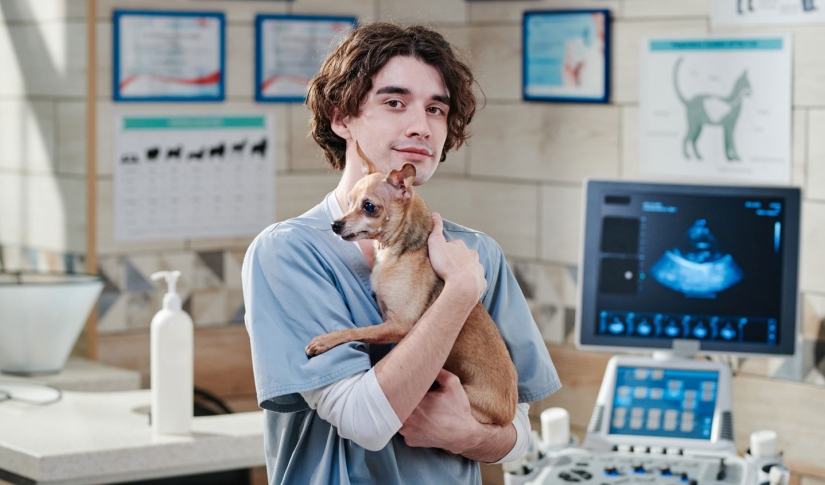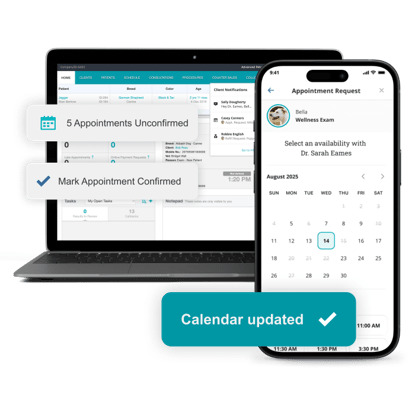The Veterinary Client Experience: Avoiding Common Pitfalls

The veterinary industry relies on pet owners for consistent business. Veterinary clients expect convenient, caring interactions with their pets’ caregivers, and their experiences in the clinic determine whether they return. Veterinary teams and leaders must understand how to shape a positive client experience with careful attention to each touch point in the process.
A seamless client journey, whether for a new client visit or a long-time loyal customer, is critical to building trust, developing lasting relationships, and establishing a positive reputation in the community. However, clients’ and team members’ perspectives can vary wildly, and miscommunication can lead to negative experiences.
Understanding veterinary care from the client’s perspective can help your team overcome common pitfalls and provide exceptional service during each and every interaction.
What is the veterinary client journey?
Let’s go through a typical client journey from booking to next-day follow-up. Each step a client takes offers an opportunity to “wow” them.
- Discovery — Your first impression matters! Clients often investigate new businesses using social media to get a glimpse of who you are and what you’re about.
- Appointment booking — After deciding your veterinary practice is the right fit, clients must schedule an appointment, often speaking with a staff member over the phone.
- Reminders — Emails, texts, and phone calls reminding clients of their upcoming appointments continue to set the tone and expectations for the visit.
- Check-in — Clients begin judging their experience the moment they enter the building. Front desk staff responsiveness and attitude, hospital cleanliness, lobby atmosphere, and wait times can all impact client satisfaction.
- Exam and consultation — Clients continue assessing value and fit in the exam room based on how the team interacts with their pet and the quality of communication and connection.
- Discharge — After the exam, client communication regarding overall pet health and the reason for that day’s visit is critical. Depending on the team’s communication skills, clients may leave feeling confident, confused, or somewhere in between.
- Check-out — On the way out, clients pay their invoice. How the veterinary clinic handles estimates and payment processing can be a touchy subject for many clients.
- Follow-up — After the client leaves, they may contact the clinic with questions or wait for team members to contact them for an update or a plan for the next steps.
Avoiding negative veterinary client experiences
Each step on the client journey is an opportunity to reinforce the veterinarian-client-patient relationship (VCPR), but a misstep can leave clients disappointed. Here are some common ways the client journey can veer off-track and how veterinary professionals can counteract or avoid them.
- Inconvenient booking — Clients anticipating an appointment scheduling struggle may put off calling or forget to schedule altogether. Offering online booking solves this and many other common veterinary team problems. Choose a practice management software system with built-in booking technology for easy use.
- Long wait times — Inefficient check-in processes, crowded lobbies, lengthy waits, and stressed front desk team members offer a less-then-ideal first impression. Streamline workflows and bottlenecks with full-featured digital software, allowing online pre-registration, document signing, and pre-visit instructions.
- Poor communication — Pet owners who leave feeling confused or overwhelmed might not adhere to their pet’s treatment plan or become repeat clients. Take time during consultations to answer questions thoroughly and follow up with digital or printed summaries.
- Pricing surprises — Always discuss pricing, payment options, and the proposed pet care plan with the client before treating their pet, even for wellness or technician visits. Transparent pricing helps normalize cost discussions so pet owners feel comfortable asking for budget-friendly alternatives.
The journey from booking to billing can make or break the veterinary client experience. Proactively addressing common issues and focusing on the pet owner’s perspective can help your team deliver exceptional veterinary care, build trust, and develop lifelong relationships with pets and clients.
Want more content like this?
Sign up for The Connected Practice Newsletter




